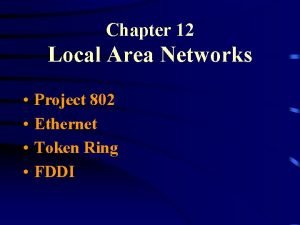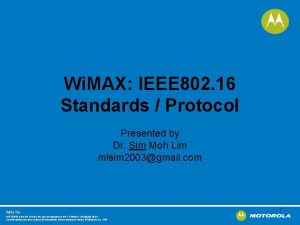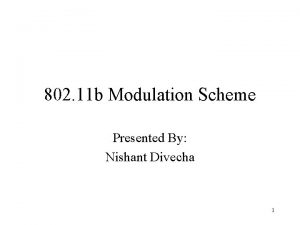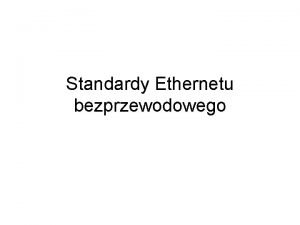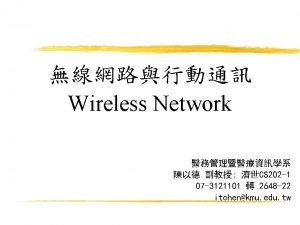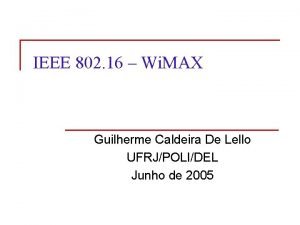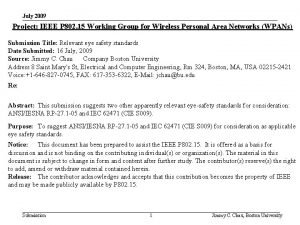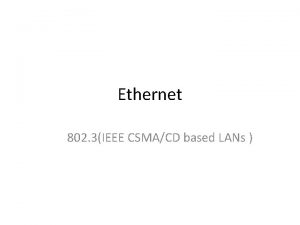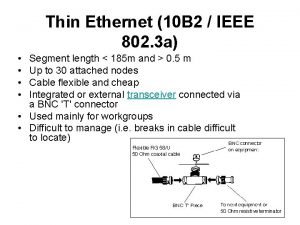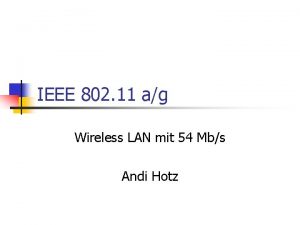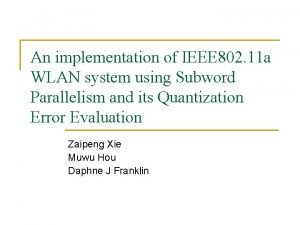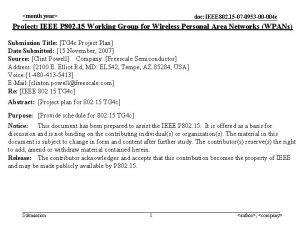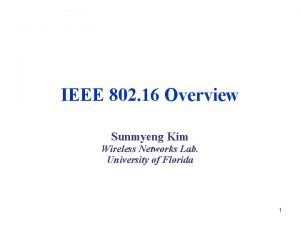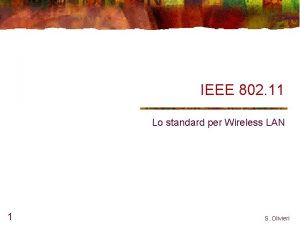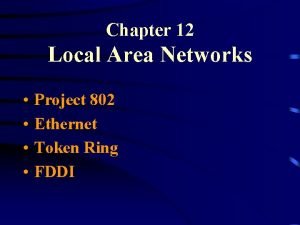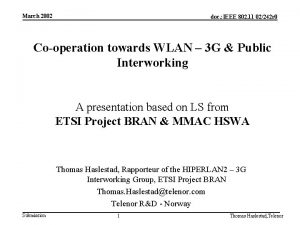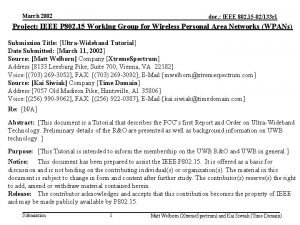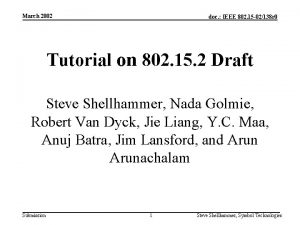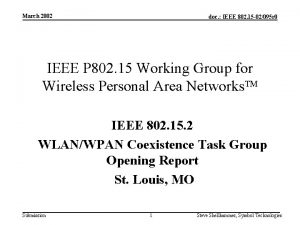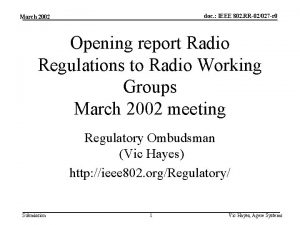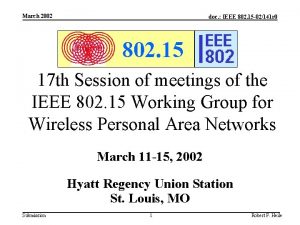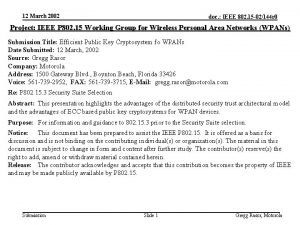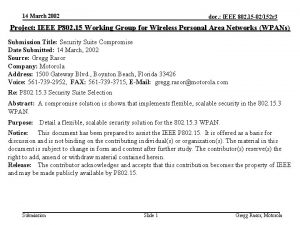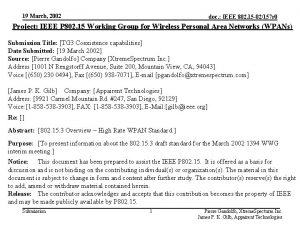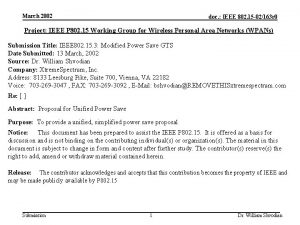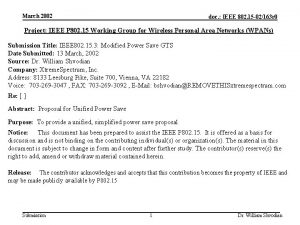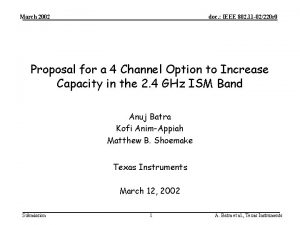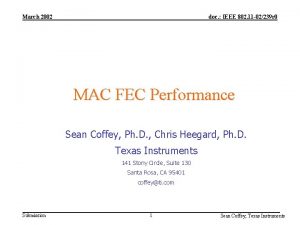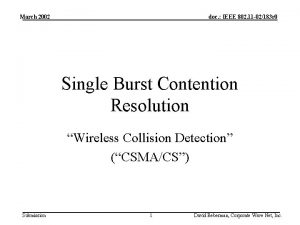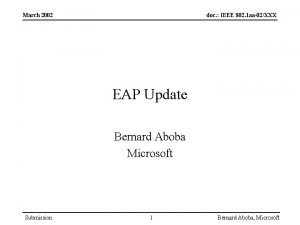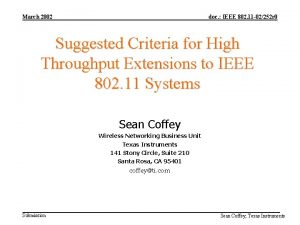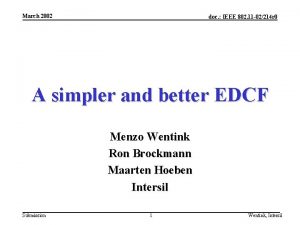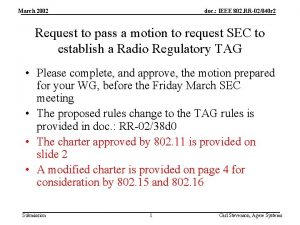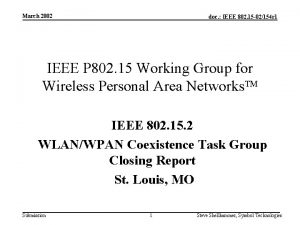March 2002 doc IEEE 802 11 RR02036 Simulation

































- Slides: 33

March 2002 doc. : IEEE 802. 11 -RR-02/036 Simulation on Aggregate Interference from Wireless Access Systems including RLANs into Earth Exploration-Satellite Service in the 5250 -5350 MHz Band Spectrum Engineering Branch Industry Canada March, 2002 Submission 1 Rebecca Chan, Industry Canada

March 2002 doc. : IEEE 802. 11 -RR-02/036 BACKGROUND Submission 2 Rebecca Chan, Industry Canada

March 2002 5150 CEPT Submission doc. : IEEE 802. 11 -RR-02/036 Current Canada/United States/CEPT provisions for RLAN applications 5250 5350 5460 5470 5570 5650 5725 5850 MHz LE-LANs permitted through Footnote C 39 A UNII devices permitted under Part 15 rules UNII devices permitted under Part 15 MOBILE SERVICE: RLAN devices 3 Rebecca Chan, Industry Canada

March 2002 5150 doc. : IEEE 802. 11 -RR-02/036 Current ITU Allocation 5250 5350 5460 5470 5570 5650 5725 MHz ARNS FSS(E-s) RADIONAV MARITIME RADIONAV Amateur EESS Srs (deep space) SRS RADIOLOC Radiolocation RADIOLOC Note: ALL CAPS=PRIMARY ALLOCATION Submission 4 Rebecca Chan, Industry Canada

March 2002 5150 doc. : IEEE 802. 11 -RR-02/036 WRC-03 consideration 5250 5350 5460 5470 5570 5725 MHz 5650 ARNS FSS(E-s) RADIONAV MARITIME RADIONAV Amateur EESS SRS RADIOLOCATION Radiolocation Submission RADIOLOC MS/ms – RLANs FS/fs – FWA (R 3) Srs (deep space) SRS 5 Rebecca Chan, Industry Canada

March 2002 doc. : IEEE 802. 11 -RR-02/036 Overall Comparison of Allocations and provisions for RLANs and other services in the 5 GHz range 5150 5250 5350 ARNS 5470 5460 5570 5650 5725 MHz ARNS FSS(E-s) RADIONAV MARITIME RADIONAV Amateur EESS SRS RADIOLOC Srs (deep space) RADIOLOC SRS RADIOLOCATION MS/ms – RLANs FS/fs – FWA (R 3) 5850 MHz LE-LAN: Footnote C 39 A LE-LANs Footnote C 39 A UNII : Part 15 rules UNII: Part 15 CEPT Submission MS MS 6 Rebecca Chan, Industry Canada

March 2002 5150 doc. : IEEE 802. 11 -RR-02/036 Current Canada/United States/CEPT technical rules for RLAN applications 5250 5350 5460 5470 5570 5650 Indoor/Outdoor Tx Power= 1 W EIRP= 4 W Indoor/Outdoor Indoor Only Tx Power= 250 m. W EIRP =200 m. W EIRP = 1 W Submission 5850 MHz Indoor/Outdoor Tx Power=1 W EIRP=4 W Indoor/Outdoor Indoor Only Tx Power =250 m. W EIRP = 200 m. W EIRP = 1 W CEPT 5725 Indoor Only EIRP = 200 m. W ATPC, DFS Indoor/Outdoor EIRP = 1 W ATPC, DFS 7 Rebecca Chan, Industry Canada

March 2002 doc. : IEEE 802. 11 -RR-02/036 Characteristics of EESS Submission 8 Rebecca Chan, Industry Canada

March 2002 doc. : IEEE 802. 11 -RR-02/036 Characteristics of EESS in the 5 GHz range 5250 5350 MHz • Radar scatterometers – useful for determining the roughness of large objects such as ocean waves • Radio altimeters – used to determine the height of the Earth's land ocean surfaces EES SRS RADIOLOC MS/ms – RLANs FS/fs – FWA (R 3) Submission • Imaging radars (synthetic aperture radars) – used to produce high resolution images of land ocean surfaces. • In this analysis only one of the imaging radars (SAR 4 -most sensitive) and altimeters were examined 9 Rebecca Chan, Industry Canada

March 2002 doc. : IEEE 802. 11 -RR-02/036 Characteristics of SARs in the 5 GHz range Parameter SAR 2 SAR 3 SAR 4 Orbital Altitude 600 km (circular) 400 km (circular) Orbital inclination 57 degrees Frequency 5405 MHz 5300 MHz Peak Radiated Power 4800 W 1700 W Pulse Bandwidth 310 MHz 40 MHz Antenna Orientation 20 -38 deg from nadir 20 -55 deg from nadir Receiver Noise Figure 4. 62 d. B Footprint 164. 3 km 2 225. 3 km 2 76. 5 km 2 Receiver Bandwidth 356. 5 MHz 46 MHz Noise Power -113. 84 d. BW -122. 73 d. BW Interference Threshold -119. 84 d. BW -128. 73 d. BW Submission 10 Source: ITU-RChan, Doc Industry 8 A-9 B/98 Rebecca Canada

March 2002 doc. : IEEE 802. 11 -RR-02/036 Characteristics of outdoor WAS/RLANs Submission 11 Rebecca Chan, Industry Canada

March 2002 doc. : IEEE 802. 11 -RR-02/036 Outdoor WAS in the 5250 -5350 MHz Range Parameter Value Frequency 5. 3 GHz Bandwidth 20 MHz Antenna Gain Pattern – azimuth plane Omnidirectional (for simulation purposes) Antenna Gain pattern – elevation plane Implicit within proposed EIRP mask to be shown later Antenna tilt 0 degrees Cell radius 1. 5 km Transmitter Power 250 m. W Scattering Coefficient 17 d. B Active Ratio 100% Submission 12 Rebecca Chan, Industry Canada

March 2002 doc. : IEEE 802. 11 -RR-02/036 EIRP mask used in simulation -14 d. BW/MHz -14 -0. 711 ( -5) d. BW/MHz -38. 9 -1. 222( -40) d. BW/MHz -45 d. BW/MHz Submission for for 0° ≤ < 5 ° 5° ≤ < 40 ° 40° ≤ < 45 ° > 45 ° =elevation angle above the local horizon For <0, EIRP= -13 d. BW/MHz Rebecca Chan, Industry Canada 13

March 2002 doc. : IEEE 802. 11 -RR-02/036 Characteristics of indoor WAS/RLANs Submission 14 Rebecca Chan, Industry Canada

March 2002 doc. : IEEE 802. 11 -RR-02/036 Characteristics of Indoor WAS systems Indoor Type 1 Indoor Type 2 Value Parameter Frequency 5. 3 GHz Bandwidth 20 MHz Antenna Isotropic (for simulation purposes) Antenna gain 0 d. Bi Transmitter power 250 m. W 200 m. W Building loss 18 d. B Active Ratio 100% Submission 15 Rebecca Chan, Industry Canada

March 2002 doc. : IEEE 802. 11 -RR-02/036 Distribution of WAS/RLANs Submission 16 Rebecca Chan, Industry Canada

March 2002 doc. : IEEE 802. 11 -RR-02/036 Distribution of WAS/RLANs • Based on population data from the UN, cell radius of WAS/RLANs and perceived deployment rate. Deployment factor of 30% was used. See ITU-R Doc. 8 A-9 B/83 • City A (extremely large city) – Population = 17. 6 million – Include effects of stations operating in sub-urban areas surrounding the city as well as to simulate effects of aggregate interference from stations operating in near-by cities, the radius was extended from 54 km to approximately 81 km. • City B (medium size city) – Population = 3. 7 million – Radius of this city = approximately 12 km. An actual radius of 18 km was used to account for effects from stations operating in sub-urban areas as well as effects from near-by cities. Submission 17 Rebecca Chan, Industry Canada

March 2002 doc. : IEEE 802. 11 -RR-02/036 Distribution of WAS/RLANs Case 1 Case 2 Case 3 Indoor Type 1 Indoor Type 2 Indoor Type 1 Number of active systems 440 440 Deployment Area (km 2) 76. 5 Density (number of active systems/km 2) 5. 75 Large city City A Medium city City B 870 43 Deployment Area (km 2) 13122 648 Density (number of active 2) systems/km Submission 0. 066 Indoor Outdoor Number of active systems 18 Rebecca Chan, Industry Canada

March 2002 doc. : IEEE 802. 11 -RR-02/036 Methodology • Within each cell: – one station transmitting at all times • One-third of all transmitters has an additional scattering coefficient of 17 d. B • 3 d. B polarization loss for outdoor systems • 0 d. B polarization loss for indoor systems • no atmospheric attenuation is assumed • The satellite was simulated to run for a period of 30 days, the period of time in which the EESS would receive maximum interference was then revisited with time steps of 200 milliseconds. The results shown here represent a period of time in which the EESS would be visible by the WAS systems in a single orbit in which EESS would experience the maximum possible interference from the aggregate interference of WAS. • Free space propagation • Building loss = 18 d. B Submission 19 Rebecca Chan, Industry Canada

March 2002 Submission Simulation 20 doc. : IEEE 802. 11 -RR-02/036 Rebecca Chan, Industry Canada

March 2002 doc. : IEEE 802. 11 -RR-02/036 Results of simulation Submission 21 Rebecca Chan, Industry Canada

March 2002 doc. : IEEE 802. 11 -RR-02/036 Aggregate interference from indoor and outdoor WAS into SAR 4 at 20 degrees from nadir Submission 22 Rebecca Chan, Industry Canada

March 2002 doc. : IEEE 802. 11 -RR-02/036 Aggregate interference from indoor and outdoor WAS into SAR 4 at 55 degrees from nadir Submission 23 Rebecca Chan, Industry Canada

March 2002 doc. : IEEE 802. 11 -RR-02/036 Aggregate interference from indoor and outdoor WAS into an altimeter Submission 24 Rebecca Chan, Industry Canada

March 2002 EESS WAS doc. : IEEE 802. 11 -RR-02/036 Summary of Result SAR 4 @ 20 deg from nadir SAR 4 @ 55 deg from nadir Altimeter Case 1 Case 2 Case 3 Case 1 -145. 36 -143. 05 Maximum interference (d. BW/MHz) -142. 9 -143. 8 -143. 9 -138. 3 -139. 1 -138. 7 -- Duration of time in which Interference > Interference criterion 1. 6 sec 1. 4 sec 1 sec 3. 2 sec 2. 8 sec 0 (see Table 7) Interference criterion (d. BW/MHz) (100% of the time) Submission 25 Rebecca Chan, Industry Canada

March 2002 doc. : IEEE 802. 11 -RR-02/036 Observations • Actual deployment of WAS indoor and outdoor is expected to be less than what is assumed in this analysis. • The result represents worst case interference for the EESS – interference is expected to be less at any other time. Submission 26 Rebecca Chan, Industry Canada

March 2002 doc. : IEEE 802. 11 -RR-02/036 EIRP mask • Based on comparison of results between City A and City B, the EIRP mask for outdoor WAS can be increased by at least 3 d. B and the interference criterion for the SAR should still be met for the vast majority of cities in the world. Hence, the EIRP mask can be modified as follows: -11 d. BW/MHz 0 <5 -11 - 0. 711( – 5) d. BW/MHz 5 < 40 -35. 9 - 1. 222 ( - 40) d. BW/MHz 40 < 45 -42 d. BW/MHz 45 where is the elevation angle above local horizon in degrees. • However, since a maximum EIRP of 1 W (-13 d. BW/MHz) is allowed, the proposed EIRP mask then becomes… Submission 27 Rebecca Chan, Industry Canada

March 2002 doc. : IEEE 802. 11 -RR-02/036 Proposed EIRP mask for outdoor WAS/RLANs -13 d. BW/MHz -13 - 0. 711( – 5) d. BW/MHz -35. 9 - 1. 222 ( - 40) d. BW/MHz -42 d. BW/MHz 0 <5 5 < 40 40 < 45 45 where is the elevation angle above local horizon in degrees. Submission 28 Rebecca Chan, Industry Canada

March 2002 doc. : IEEE 802. 11 -RR-02/036 Further Simulation Submission 29 Rebecca Chan, Industry Canada

March 2002 doc. : IEEE 802. 11 -RR-02/036 Further simulation • Regulatory concerns on how to enforce the proposed outdoor EIRP mask • Simulation performed for SAR 4 operating at 55 degrees from nadir • Assumed ALL of the WAS/RLANs were pointing upward, although still using the EIRP mask as proposed. • Pointing angles assumed: 0 to 10 and 0 to 20 degrees Submission 30 Rebecca Chan, Industry Canada

March 2002 doc. : IEEE 802. 11 -RR-02/036 Further simulation Submission 31 Rebecca Chan, Industry Canada

March 2002 doc. : IEEE 802. 11 -RR-02/036 Conclusion Submission 32 Rebecca Chan, Industry Canada

March 2002 doc. : IEEE 802. 11 -RR-02/036 Conclusion • With respect to sharing between EESS and WAS/RLANs in the 5250 -5350 MHz – Sharing appears to be feasible given that indoor systems have a maximum EIRP of 250 m. W and that outdoor systems employ certain technical constraints such as the EIRP mask as proposed • With respect to sharing between EESS and WAS/RLANs in the 5470 -5570 MHz range – Further studies are required to examine the impact on wideband SARs (SAR 2 and SAR 3) • Not covered in this presentation – sharing between WAS/RLANs and Radiolocation in the 5 GHz range Submission 33 Rebecca Chan, Industry Canada
 Bridges from 802.x to 802.y
Bridges from 802.x to 802.y Bridges from 802.x to 802.y
Bridges from 802.x to 802.y Poland national anthem lyrics
Poland national anthem lyrics Ieee 802 standard
Ieee 802 standard Ieee 802 bluetooth
Ieee 802 bluetooth 802 ieee
802 ieee Ieee 802
Ieee 802 Ieee 802 family
Ieee 802 family Ieee 802 3 compliance
Ieee 802 3 compliance Ieee802.22
Ieee802.22 Arquitetura ieee 802
Arquitetura ieee 802 Ieee 802 que es
Ieee 802 que es What is project 802
What is project 802 802 16
802 16 802 11
802 11 Standardy 802
Standardy 802 802 5
802 5 802 family
802 family 802 16
802 16 802 protocols
802 protocols Ccna 640-802
Ccna 640-802 09 802 0561
09 802 0561 Ethernet 802
Ethernet 802 802-3-ethernet
802-3-ethernet Ssin-802
Ssin-802 Lan 701
Lan 701 Wireless lan 802
Wireless lan 802 Wlan 802
Wlan 802 802 15
802 15 Ssin-802
Ssin-802 802-11-iapp
802-11-iapp 802/11
802/11 802 3
802 3 Project 802
Project 802












